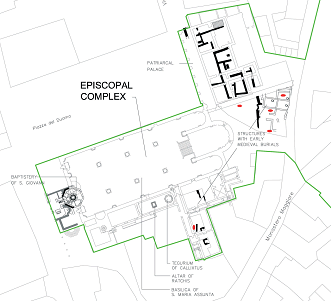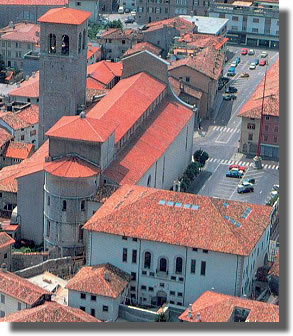CIVIDALE DEL FRIULI
Episcopal complex
EPISCOPAL COMPLEX
The complex included a series of interconnected buildings, comprising the Basilica of Santa Maria Assunta, the Baptistery of San Giovanni Battista, and the Patriarch’s Palace below the Museo Archeologico Nazionale (Palazzo dei Provveditori Veneti).
The complex occupied a hillock immediately to the north of the Valle area. Here, within the area of today’s Duomo, an octagonal Baptistery was rediscovered, which had been made more monumental by a Tegurium, or baldaquin, added by Patriarch Callixtus, and possibly also by adding the Altar of Ratchis (today held in the nearby “Christian and Duomo’s Teasure Museum”).
The history of the Longobard duchy of Friuli is entwined with that of the patriarchal seat of Aquileia. As soon as the Longobards descended into Italy, the bishop of Aquileia, Paolinus (reigned 557-569 A.D.) decided to flee to the coastal city of Grado, also bringing the treasures belonging to the Church of Aquileia.
 |
 |
The Episcopal complex with the Museo Archeologico Nazionale
The patriarchal title was duplicated between Grado and Aquileia, and after this, probably sometime between 608 and 628, the Patriarch of Aquileia, who resided in the territory of the Longobards, moved from the city of Aquileia into the castrum of Cormons.
In 737 the Patriarch Callixtus, encouraged by King Liutprand, transferred his residence from Cormons to Cividale, evicting the praesul Amatore (a governing clerical figure) of the town of Iulium Carnicum who had earlier established his residence in the city as agreed with Duke Pemmon (father of Ratchis and Astulf).
The arrival in Cividale of Callixtus (737-757) coincided with a period of great political and cultural prosperity for the Longobard Duchy of Friuli and the city enjoyed a period of great splendour.
Patriarch Callixtus (737-757) is credited with the renewal and enlargement of the church complex which became the Episcopal seat during this same period of Longobard domination:
”…post haec Patriarcha (Calistus) ad Civitatem rediens, ibi
Ecclesiam, et baptisterium Sancti Johannis,
atque Palatium Patriarchale construxit…”.
The structures of the Patriarch’s Palace, adjacent to the Basilica of Santa Maria, were rediscovered under the area of the Palazzo dei Provveditori Veneti, designed by Andrea Palladio, and the seat of today’s Museo Archeologico Nazionale.






